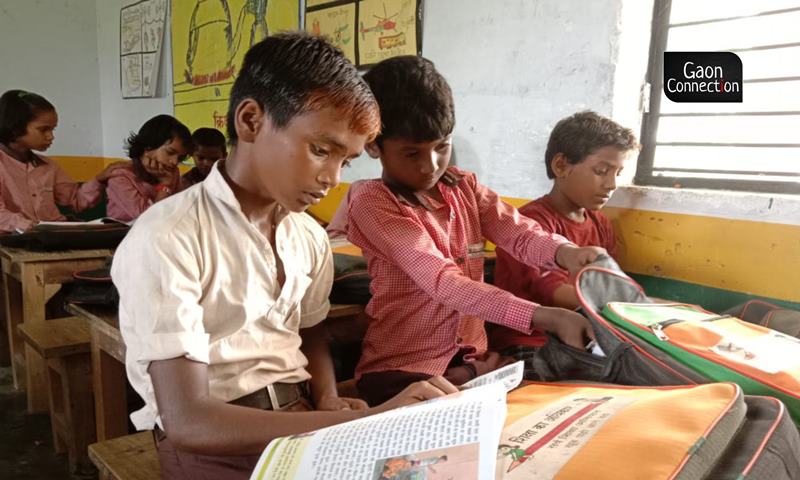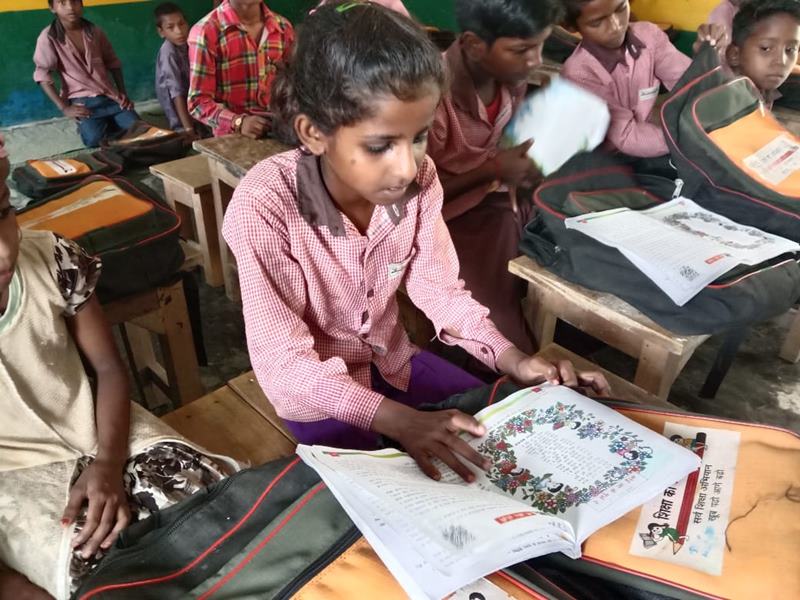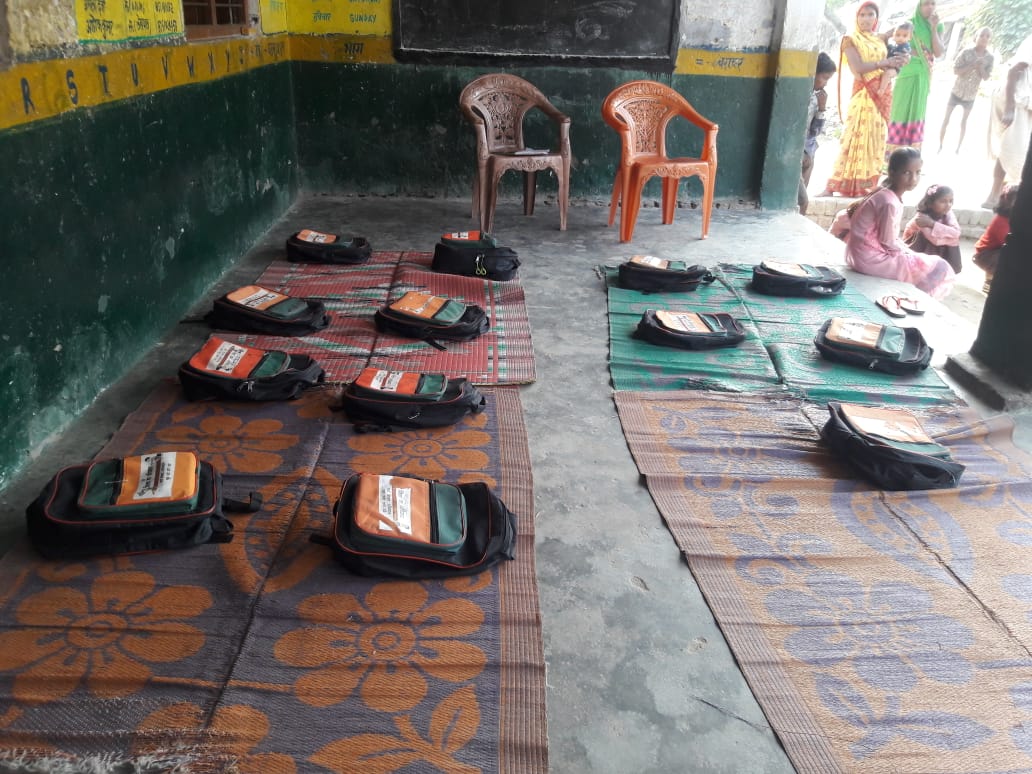Back To School: Classrooms have reopened in Uttar Pradesh, but where are the textbooks, ask students
While Uttar Pradesh has thrown open primary schools on September 1, students are yet to receive their books and stationery to start their classes after 18 months. Gaon Connection spoke with students and teachers of government schools in Unnao and Barabanki.


The schools in UP seemed unprepared to receive their students with books and stationery. Photo: Virendra Singh
Sumit Yadav and Virendra Singh
Unnao and Barabanki, Uttar Pradesh
It has been a long long year and more since schools resonate with the chatter of children, voices of teachers and the scratch of chalk on the blackboards. The COVID19 pandemic set back education in the country with alarming reports that say many children have dropped out and may never return to school.
When at last the announcement of the reopening of schools in phases was made and primary schools across Uttar Pradesh reopened for offline classes on September 1, there was jubilation, amongst the teaching community, parents and the children.
A primary school called Shivpur Grant in Bichhiya Block of Unnao district, Uttar Pradesh, threw open its door after nearly seventeen months. Class three student Shivani was back in school with her backpack that held only a couple of battered books from over a year ago and a few pencils. “We were told we would get new books and copies, but we have not yet got anything,” Shivani told Gaon Connection.
Even three days into the new term after a long long break, the schools seemed unprepared to receive their students with books and stationery.
Meanwhile Rajveer Varma of second standard at Shivpuri Grant school decided he would not go to school because he had lost all his earlier books and felt it was pointless going to school with no books.
Every year all the students in government schools receive free books, bags, uniforms, shoes and socks from the state government. The district administration is supposed to provide these to children every academic session. Unnao district has 16 blocks where there are 2,259 rural and 46 urban government schools with approximately 18,6362 enrolled students.

“We have forty three students who have registered for this term at school. But we are yet to receive the new books. The classes have commenced with oral teaching and learning,” Raj Kishore, headmaster of Shivpuri Grant Primary School, told Gaon Connection. The teachers are setting homework from some old books the children already had, he added.
Raj Kishore said they were hoping to get the new consignment of books and stationery for the children in a couple of days after which they would be distributed.
COVID’s impact on education sector
The pandemic threw a spanner in the works of education in the country, and there is a very real fear that many students will not return to the classrooms, especially the girls. There has been a spike in cases of child marriages too, and these young girls, some of them not even teenagers, have been married off and will never see school again.

According to a survey conducted by Right to Education Forum in collaboration with the Centre for Budget and Policy Studies and United Nations Educational, Scientific and Cultural Organization (UNESCO), boys were being given priority over girls in online studies due to lack of computers or adequate number of mobile phones at home.
On March 21, earlier this year, United Nations Children Emergency Fund (UNICEF) published a report titled COVID-19 and School Closures: One year of education disruption. According to the report a mere 8.5 per cent school students in India have internet access and the disruption of education in the country due to COVID19 is second worst in South Asia — second only to Afghanistan.
On being contacted seeking clarification on why students had not received their textbooks, notebooks and uniform, Jai Singh, basic education officer, Unnao, told Gaon Connection: “We have received the new books and they have been dispatched to block offices from where they will be sorted and distributed to the schools.”

Textbook distribution in Barabanki
In Barabanki district, Uttar Pradesh, some, not all, of the new books have reached the school students.
“We have seven books prescribed for our course, but we have received just two of them and masterji said we will start with those till such time the others arrive,” Sheru, a class five student of Chiraiya Prathmik Vidyalaya, Fatehpur, told Gaon Connection.
“We have received the first consignment of the books just now,” Taukeer Khan, Principal, Chiraiya Prathmik Vidyalay, told Gaon Connection. But the list is incomplete and some classes have received nothing yet, he added. “We have started teaching with whatever books we have at hand.”
“Authorities have assured us that the rest of the books will be sent to us soon,” the principal said.
In Barabanki, 2,636 council schools have started functioning since September 1. About 35,2743 children await their new books in the district, and most schools have not yet received them.
However, Ajay Kumar Singh, basic education officer of Barabanki, told Gaon Connection that books are being sent out from the Block Resource Centre at Barel, and 96 per cent of them have reached students at schools in Barabanki. “By Saturday (September 4), all the books will be dispatched,” he said.

Does the opening of schools rekindle hope? It definitely does say educators. About 440 million children have been out of schools for nearly 18 months.
“The pandemic threatens to reverse decades of progress,” Santhya Vikram, educator and activist for children, and founder of Yellow Train school in Coimbatore, Tamil Nadu, feared. According to her, being confined in their homes have left many children vulnerable to violence, exploitation and abuse.
“While the more privileged have had access to online classes and interaction with their teachers and peers, there are millions out there who have been completely cut off,” she added.
But, Vikram cautioned, stakeholders and authorities in the field of education must be mindful. The lockdown did not impact all children equally and the loss of learning has also been different. Some were worse off than the others.
The transition from lockdown to school reopening has to be a considered one with governments adopting a differentiated approach between government schools and the private ones.

